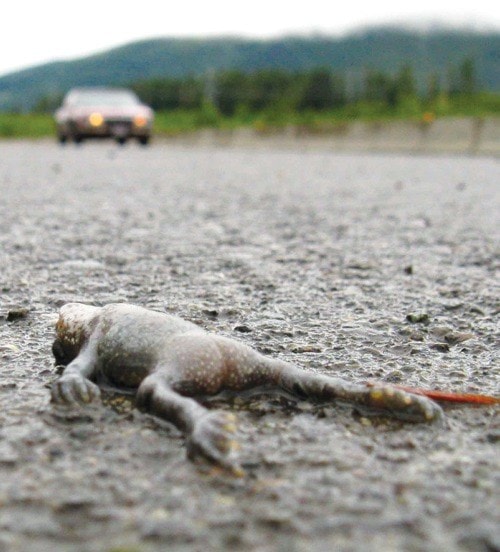Hopping across four lanes while dodging giant machines tearing by you at 100 km/h is a task any sane person would consider suicidal.
For amphibians and reptiles on breeding migrations, it’s a ‘damned-if-you-do, damned-if-you-don’t’ proposition – make the attempt and risk violent death or stay put and forego breeding.
So many frogs, salamanders and snakes are killed by vehicles on Vancouver Island they might be losing the battle to perpetuate their species.
To get a better handle on the severity of the problem, Nanaimo hosted the Herpetofauna and Roads Workshop last month to bring scientist, environmental managers, biological and environmental consultants, engineers and non-governmental organizations together to look at the toll roads take on these creatures and what can be done to lessen the impacts.
The workshop drew 90 experts from B.C., Ontario, Washington, Oregon and Hungary.
Elke Wind, wildlife biologist and lead organizer for the workshop, said amphibians, especially western toads, the Island’s only toad species, face high risks on migration routes near Nanaimo, Courtenay, Qualicum and Duncan.
“We have a site here in Nanaimo, along Nanaimo Lakes Road, where we have migration issues,” Wind said. “By discussing it and raising awareness, we learn about more sites all the time. Often the public knows of where there are mortality issues, but we haven’t been informed of them yet.”
The conference focused on all types of amphibians, but toads get noticed most because they migrate en masse during daylight hours.
“The toads have been great for bringing the issue to the forefront, but we also want to bring attention to other species,” she said.
Why should anyone care?
Amphibians, because of their numbers, carry the highest biomass of any other species on the Island, Wind said.
When they migrate, their bodies move large amounts of nutrients consumed in one location and transport them to breeding sites. They are primary predators of insects and other small animals and in turn are an important food source for other predators. The existence and stability of entire ecosystems depend on healthy amphibian populations and their migrations.
Speakers at the conference came from as far as Hungary, Wind said, because organizer “wanted to get the European perspective on this because they’re quite a bit farther ahead of us when it comes to transportation and wildlife issues.”
The American bullfrog invasion in the late 1990s could prove less of a long-term environmental threat than was originally feared. Wind said eradicating attempts would be costly with little chance of success. Native species might cope with them given the right conditions.
"What we're really pushing for now - and this is one of our biggest issues - is the loss of ephemeral wetlands," Wind said. "These small wetlands don't have any protection and they're kind of an oasis for our native species because bullfrogs can't breed in them. Bullfrogs need permanent water."
Development threatens ephemeral wetlands, which swell to small ponds in winter, but dry out in summer. Most locations are not mapped, so developers do not realize they destroy critically important amphibian habitat.
"What we do is replace them with little permanent water bodies - storm water ponds, golf course ponds - and that facilitates the spread of bullfrogs," Wind said.
Less is known about the condition of the Island's salamanders and newts, which are more difficult to study. Wind said salamanders seem to be doing ok.
"One of the biggest issues we're dealing with globally is disease," she said. "There's a chytrid fungus that's been wiping populations out. We know it occurs in B.C. We know we have it on the Island. Toads are particularly vulnerable to it."
Chytridiamycosis spreads rapidly and can quickly wipe out even strong, healthy amphibian populations.
